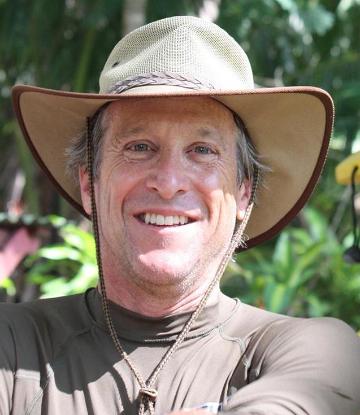
Find Your Voice During National Poetry Month
April is National Poetry Month, but for Santa Clara University’s Kirk Glaser, every day is a celebration of poetry and creative writing.
As an award-winning poet, Director of Creative Writing, and faculty advisor to the Santa Clara Review—one of the oldest literary publications in the Western U.S.—Glaser tries to increase awareness and appreciation of poetry by teaching how words are sounds with pitch and duration and cadence, not just units of meaning.
"Words are akin to paint on a brush, or are like chemicals—put them together and strange reactions happen,” he says. “Words make images that somehow contain feelings, metaphors that yoke the unexpected to create a new awareness. And every word counts.”
We talked to Glaser about embarking on a poet's life, whether writing for publication or just for yourself.
How does someone learn to write poetry?
Read what others do. And just write, every day. Do these two things regularly, and you’ll find your voice. There are so many great books and websites. A fabulous resource is the Poetry Foundation website. This site is home to Poetry Magazine, one of the oldest and greatest, and it has an incredible repository of poets and poetry from the classics to contemporary— far beyond all the poems that magazine has published. You can search by poet and by theme, and it has many other resources—audio, interviews, poets writing about poetry, and podcasts.
I highly recommend Poetry Off the Shelf, with Curtis Fox, short podcasts where he interviews poets and has them read and talk about their or others’ poems, often addressing themes.
Another terrific website is Motion Poems. For about eight seasons, they have been pairing contemporary poems and filmmakers to create incredible short films that make poetry highly accessible, entertaining, and provocative. There are lots of great books on learning to write poetry. My favorite, especially for beginners, is The Poet’s Companion by Kim Addonizio and Dorianne Laux—great chapters on different themes and elements of craft, and the best writing prompts I have ever found.
What three poems of yours would you recommend to readers, and why?
Well, I would point them to some of my poems online because they are the most accessible. The latest issue of Marsh Hawk Review (Fall 2018) has a poem, “Inheritance of Fire,” that captures the essence of a collection I am currently seeking to publish. Another, “Leaf of Ash,” is not online but is in Catamaran Literary Reader (Summer 2017), an incredibly beautiful journal of poetry, fiction, non-fiction and art. It captures my eco-poetics well. “Practicing Tai Chi While News Plays From Tiananmen Square,” shows a more political side to my work and is online at Cerise Press (Fall/Winter 2010-11).
How would you describe the relationship between poetry and song lyrics?
The relationship to song lyrics and poetry is problematic. Many songs may feel like poetry, but most lyrics rely on the music to work. Take the music away, and the words starve. There’s not the attention to how the words work on their own to sustain the music of poetry. Of course, there are song writers who are poets—Kendrick Lamar, Leonard Cohen, Patti Smith come immediately to mind, and there are many others, but I am wary to start people on the path of poetry with songs.
Sure, song lyrics can inspire poetry, and many great songwriters use poetic elements and the sounds of words brilliantly, even if the songs are not poems. But the danger of song lyrics as a model for beginning poets is that they limit one’s scope, both in content and style. Different genres of music have their own metrical patterns, but they tend to be narrow.
I started writing poetry that sounded like rock lyrics. Terrible. Now students often imitate rap and hip hop. Same problems—imitation and limitation. Sure, some can do it well, but there is so much terrific contemporary poetry being written, I prefer to send people there. Read Ross Gay or Terrance Hayes or Ada Limon or Elizabeth Bishop or Robert Hass or… you get the idea.
Why do you call writing poetry a kind of therapy?
Writing poetry is a way to tap the unknown. To write poetry requires taking the time to turn inward, to listen deeply, to make language create what you don’t know you know....And I find it imperative to say, poetry is an antidote to the chatter of our society, asking questions and expressing awareness that the dominant culture smothers. Poems are a way to use language that subverts the master narratives of capitalism and political speech and certain media that deaden language and imagination.
You’re known for making meditation part of the writing process for your students, to help “open the creative being.” Can you elaborate?
I start every class with meditation, sometimes reading a poem or guiding students through their senses or memories to tap material. We write immediately following that. It’s a strange thing, but the more you can silence the chatter in the head, the more silence you can find, the more readily words arise to capture what you are feeling or experiencing.
The school of Vipassana (meditation) that I practice may seem demanding at first—10-day silent retreats, meditating for an hour every morning and evening. But even five minutes of sitting quietly before writing—observing the breath or sensation in the body or the soundscape around you, without thinking or reacting—can be incredibly valuable for finding what really matters in the moment, for stilling the surface mind, plumbing the depths of your being, and coming up with the words that tell you what you need to know or be aware of. And perhaps opening you to the “not-me” that connects you to everything else, even in the solitude of your writing space.

